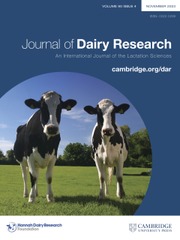Crossref Citations
This article has been cited by the following publications. This list is generated based on data provided by
Crossref.
Saatchi, Mahdi
Garrick, Dorian J
Tait, Richard G
Mayes, Mary S
Drewnoski, Mary
Schoonmaker, Jon
Diaz, Clara
Beitz, Don C
and
Reecy, James M
2013.
Genome-wide association and prediction of direct genomic breeding values for composition of fatty acids in Angus beef cattlea.
BMC Genomics,
Vol. 14,
Issue. 1,
Bernard, L.
Leroux, C.
and
Chilliard, Y.
2013.
Stearoyl-CoA Desaturase Genes in Lipid Metabolism.
p.
161.
Cánovas, A.
Rincón, G.
Islas-Trejo, A.
Jimenez-Flores, R.
Laubscher, A.
and
Medrano, J.F.
2013.
RNA sequencing to study gene expression and single nucleotide polymorphism variation associated with citrate content in cow milk.
Journal of Dairy Science,
Vol. 96,
Issue. 4,
p.
2637.
Baeza, M. C.
Corva, P. M.
Soria, L. A.
Pavan, E.
Rincon, G.
and
Medrano, J. F.
2013.
Genetic variants in a lipid regulatory pathway as potential tools for improving the nutritional quality of grass‐fed beef.
Animal Genetics,
Vol. 44,
Issue. 2,
p.
121.
Nafikov, R.A.
Schoonmaker, J.P.
Korn, K.T.
Noack, K.
Garrick, D.J.
Koehler, K.J.
Minick-Bormann, J.
Reecy, J.M.
Spurlock, D.E.
and
Beitz, D.C.
2013.
Sterol regulatory element binding transcription factor 1 (SREBF1) polymorphism and milk fatty acid composition.
Journal of Dairy Science,
Vol. 96,
Issue. 4,
p.
2605.
Raven, Lesley-Ann
Cocks, Benjamin G
Goddard, Michael E
Pryce, Jennie E
and
Hayes, Ben J
2014.
Genetic variants in mammary development, prolactin signalling and involution pathways explain considerable variation in bovine milk production and milk composition.
Genetics Selection Evolution,
Vol. 46,
Issue. 1,
p.
29.
Fariello, Maria-Ines
Servin, Bertrand
Tosser-Klopp, Gwenola
Rupp, Rachel
Moreno, Carole
Cristobal, Magali San
Boitard, Simon
and
Caramelli, David
2014.
Selection Signatures in Worldwide Sheep Populations.
PLoS ONE,
Vol. 9,
Issue. 8,
p.
e103813.
Nafikov, Rafael A.
Schoonmaker, Jon P.
Korn, Kathleen T.
Noack, Kristin
Garrick, Dorian J.
Koehler, Kenneth J.
Minick-Bormann, Jennifer
Reecy, James M.
Spurlock, Diane E.
and
Beitz, Donald C.
2014.
Polymorphisms in lipogenic genes and milk fatty acid composition in Holstein dairy cattle.
Genomics,
Vol. 104,
Issue. 6,
p.
572.
Li, Cong
Sun, Dongxiao
Zhang, Shengli
Wang, Sheng
Wu, Xiaoping
Zhang, Qin
Liu, Lin
Li, Yanhua
Qiao, Lv
and
Chen, Lin
2014.
Genome Wide Association Study Identifies 20 Novel Promising Genes Associated with Milk Fatty Acid Traits in Chinese Holstein.
PLoS ONE,
Vol. 9,
Issue. 5,
p.
e96186.
Ulloa, Pilar E.
Rincón, Gonzalo
Islas-Trejo, Alma
Araneda, Cristian
Iturra, Patricia
Neira, Roberto
and
Medrano, Juan F.
2015.
RNA Sequencing to Study Gene Expression and SNP Variations Associated with Growth in Zebrafish Fed a Plant Protein-Based Diet.
Marine Biotechnology,
Vol. 17,
Issue. 3,
p.
353.
Chen, Liuhong
Ekine-Dzivenu, Chinyere
Vinsky, Michael
Basarab, John
Aalhus, Jennifer
Dugan, Mike E. R.
Fitzsimmons, Carolyn
Stothard, Paul
and
Li, Changxi
2015.
Genome-wide association and genomic prediction of breeding values for fatty acid composition in subcutaneous adipose and longissimus lumborum muscle of beef cattle.
BMC Genetics,
Vol. 16,
Issue. 1,
Li, C.
Sun, D.
Zhang, S.
Liu, L.
Alim, M. A.
and
Zhang, Q.
2016.
A post-GWAS confirming theSCDgene associated with milk medium- and long-chain unsaturated fatty acids in Chinese Holstein population.
Animal Genetics,
Vol. 47,
Issue. 4,
p.
483.
MacLeod, I. M.
Bowman, P. J.
Vander Jagt, C. J.
Haile-Mariam, M.
Kemper, K. E.
Chamberlain, A. J.
Schrooten, C.
Hayes, B. J.
and
Goddard, M. E.
2016.
Exploiting biological priors and sequence variants enhances QTL discovery and genomic prediction of complex traits.
BMC Genomics,
Vol. 17,
Issue. 1,
Deng, Tingxian
Pang, Chunying
Ma, Xiaoya
Lu, Xingrong
Duan, Anqin
Zhu, Peng
and
Liang, Xianwei
2016.
Four novel polymorphisms of buffalo INSIG2 gene are associated with milk production traits in Chinese buffaloes.
Molecular and Cellular Probes,
Vol. 30,
Issue. 5,
p.
294.
Aali, Mohsen
Moradi-Shahrbabak, Hosein
Moradi-Shahrbabak, Mohammad
Sadeghi, Mostafa
and
Kohram, Hamid
2016.
Polymorphism in the SCD gene is associated with meat quality and fatty acid composition in Iranian fat- and thin-tailed sheep breeds.
Livestock Science,
Vol. 188,
Issue. ,
p.
81.
Li, Cong
Sun, Dongxiao
Zhang, Shengli
Yang, Shaohua
Alim, M. A.
Zhang, Qin
Li, Yanhua
and
Liu, Lin
2016.
Genetic effects of FASN, PPARGC1A, ABCG2 and IGF1 revealing the association with milk fatty acids in a Chinese Holstein cattle population based on a post genome-wide association study.
BMC Genetics,
Vol. 17,
Issue. 1,
Acosta, Deanna
Bagchi, Susmita
Broin, Pilib Ó
Hollern, Daniel
Racedo, Silvia E.
Morrow, Bernice
Sellers, Rani S.
Greally, John M.
Golden, Aaron
Andrechek, Eran
Wood, Teresa
and
Montagna, Cristina
2016.
LPA receptor activity is basal specific and coincident with early pregnancy and involution during mammary gland postnatal development.
Scientific Reports,
Vol. 6,
Issue. 1,
Pegolo, S.
Cecchinato, A.
Mele, M.
Conte, G.
Schiavon, S.
and
Bittante, G.
2016.
Effects of candidate gene polymorphisms on the detailed fatty acids profile determined by gas chromatography in bovine milk.
Journal of Dairy Science,
Vol. 99,
Issue. 6,
p.
4558.
Ibeagha-Awemu, Eveline M.
Peters, Sunday O.
Akwanji, Kingsley A.
Imumorin, Ikhide G.
and
Zhao, Xin
2016.
High density genome wide genotyping-by-sequencing and association identifies common and low frequency SNPs, and novel candidate genes influencing cow milk traits.
Scientific Reports,
Vol. 6,
Issue. 1,
Bradford, Barry J.
Yuan, Kai
and
Ylioja, Caroline
2016.
Managing complexity: Dealing with systemic crosstalk in bovine physiology.
Journal of Dairy Science,
Vol. 99,
Issue. 6,
p.
4983.

